Dispersion-Compensating Prism Pairs for Ultrafast Lasers
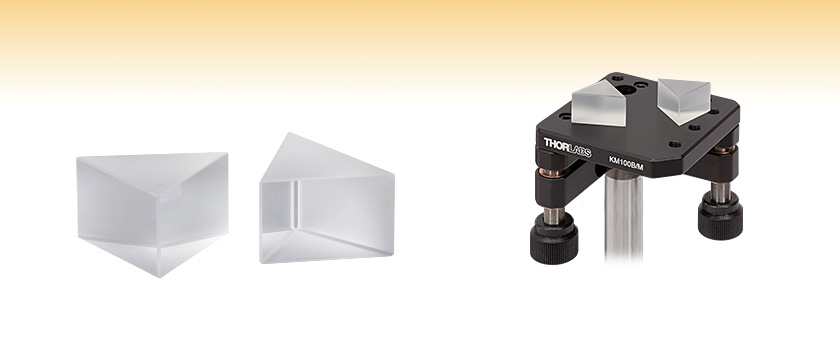
- Four Materials to Choose From
- Designed for Use at Brewster's Angle
- 700 to 900 nm Designed Spectral Range
AFS-CAF
Application Idea
AFS-FS Prisms
on a KM100B/M

Please Wait
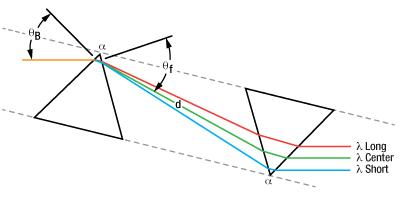
Figure 1.1 Dispersion-Compensating Prism Pair
An ultrafast-laser-dispersing prism pair with apex angle α and separation d can be used to spatially disperse different wavelength components and introduce wavelength-dependent phase changes. To learn more, please see the Tutorial tab.
| Click on the red Document icon next to the item numbers below to access the Zemax file download. Our entire Zemax Catalog is also available. |
Features
- Designed Spectral Range: 700 - 900 nm
- Apex Angle Tolerance: ±15 arcmin
- Unpolished Sides: Flat and Ground
- Surface Flatness: λ/4 at 633 nm
- Use to Compensate for Dispersion
- Fabricated from CaF2, Fused Silica, SF10, or N-SF14
These Dispersion-Compensating Prism Pairs are designed to compensate for the pulse broadening effects that occur in ultrafast laser systems without introducing significant power losses. Four large-index-of-refraction prism materials are offered to provide various group velocity dispersion (GVD) values, thereby compensating for different pulse dispersion conditions.
Applications
Prism pairs such as these have multiple applications. They can be used to create an optical filter; simply insert a knife edge to attenuate the short- or long-wavelength components. If the prism pair is placed inside a laser resonator, they can be used for wavelength tuning. Alternatively, prism pairs can be used for dispersion compensation. Each time light passes through the optical elements within a laser cavity, positive (commonly referred to as normal) dispersion occurs. The prism pair also contributes positive dispersion. However, this positive dispersion is somewhat offset by the extra distance that the longer wavelengths travel through the second prism (refer to Figure 1.1). With a careful choice of prism pair geometry it is possible to create negative (commonly referred to as anomalous) dispersion that compensates for all other elements within the cavity. To characterize the dispersion properties, including the phase, group delay, group delay dispersion (GDD), third-order dispersion, and fourth-order dispersion, please see our Chromatis™ dispersion measurement system.
For Thorlabs' full selection of optics for ultrafast applications, please see the Ultrafast Optics tab.
| Item # | Material | GVDa (at 800 nm) |
TODb (at 800 nm) |
αc (Apex Angle) |
H (mm) |
B (mm) |
ΘBd | Refractive Index (at 800 nm) |
Scratch- Dig |
|---|---|---|---|---|---|---|---|---|---|
| AFS-CAF | CaF2e | -5 fs2/cm | -12 fs3/cm | 69.9° | 12.3 | 17.2 | ~55.0° | 1.430 | 40-20 |
| AFS-FS | Fused Silica | -16.5 fs2/cm | -20 fs3/cm | 69.1° | 12.4 | 17.0 | ~55.6° | 1.453 | 20-10 |
| AFS-SF10 | SF10e | -97.5 fs2/cm | -388 fs3/cm | 60.6° | 13.0 | 15.1 | ~59.7° | 1.711 | 20-10 |
| AFS-SF14 | N-SF14 | -113.5 fs2/cm | -473 fs3/cm | 59.6° | 13.0 | 14.9 | ~60.2° | 1.743 | 20-10 |

The graphs here represent calculated Group Velocity Dispersion and Third-Order Dispersion values for prism pairs with a separation distance of 10 mm. Please see the Tutorial tab for more information.
Prism Pair Dispersion Calculations
The broadband frequency spectrum of ultrashort laser pulses brings rise to the necessity for dispersion compensation. Whenever an ultrashort pulse passes through a positive dispersive material, the pulse becomes “stretched” due to the frequency dependency of the refractive index of a material. In order to maintain pulse shape and duration, a negative dispersive system is required. While there are various methods for producing dispersion control, such as grating pairs or chirped mirrors; prism pairs offer a simple, tunable, and low loss solution for dispersion compensation. Through adjusting the relative geometry of the prism pair, the dispersion can be adjusted from positive through negative values. Please see Figures 4.2 and 4.3 for sample results.
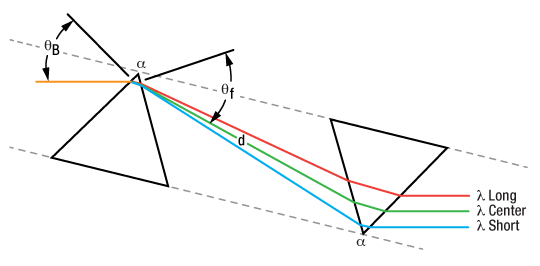 Figure 4.1 An ultrafast-laser-dispersing prism pair with apex angle α and separation d can be used to spatially disperse different wavelength components and introduce wavelength-dependent phase changes.
Figure 4.1 An ultrafast-laser-dispersing prism pair with apex angle α and separation d can be used to spatially disperse different wavelength components and introduce wavelength-dependent phase changes.As can be demonstrated through Fourier analysis, ultrashort pulses (small Δt) innately possess a broadband frequency spectrum (large Δf). However, due to the wavelength-dependent nature of the index of refraction, longer wavelengths travel faster through an optical material than short wavelengths. Consequently, femtosecond pulses are subject to pulse broadening as a result of group velocity dispersion (GVD). These effects can be reversed by using a prism pair such as those offered here to provide a negative dispersive system in order to shorten the duration of an ultrashort laser pulse.
To achieve the specified GVD values while also maximizing transmission, light should be incident on the first prism at Brewster's Angle (ΘB). As shown in Figure 4.1, the first prism is used to separate the various wavelength components. Then, a second prism is positioned such that the various wavelengths of refracted light rays will propagate parallel to each other upon exiting. Furthermore, by including another pair of prisms (4 prisms total), the final rays can be made to propagate collinearly with each other as well as with the path of the incident rays [1]. This feature can be particularly useful when installing a dispersion compensator into an existing optical system.
The apex angle in the ULD prism pairs is chosen such that the input and output angles are both near Brewster's Angle (ΘB) in order to minimize the reflection of p-polarized light.
The frequency-dependent exit angle Θf(ω) is given by

where the variables n, ΘB, and α correspond to the frequency-dependent refractive index of the prism material, angle of incidence with the surface of the first prism, and apex angle of the prism, respectively.
The accumulated phase φ(ω) in a prism pair is equal to

where the variables ω, d, Θf, and Θfshort correspond to frequency, prism separation, exit angle (frequency dependent), and exit angle of the shortest transmitted wavelength, respectively.
The first, second, and third derivatives of the accumulated phase with respect to frequency are proportional to the Group Delay (GD), the Group Velocity Dispersion (GVD) and the Third-Order Dispersion (TOD) of the prism pair, respectively.



Figures 4.2 and 4.3 represent calculated GVD and TOD values for prisms separated by a distance (d) of 10 mm and with an angle of incidence equivalent to the Brewster angle of the material (ΘB, see Specs tab for approximate values).

Click to Enlarge
Click Here for Raw Data
Figure 4.2 The calculated GVD values for prisms of various materials. Calculations were performed using a separation distance of 10 mm and an angle of incidence equivalent to the Brewster angle of the material.
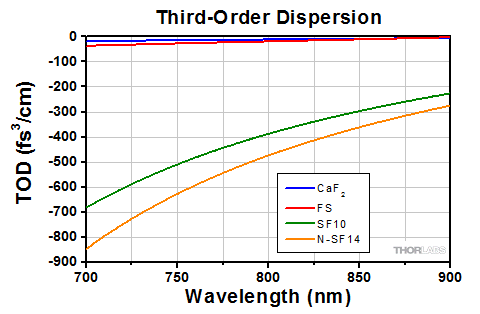
Click to Enlarge
Click Here for Raw Data
Figure 4.3 The calculated TOD values for prisms of various materials. Calculations were performed using a separation distance of 10 mm and an angle of incidence equivalent to the Brewster angle of the material.
Thorlabs offers a wide selection of optics optimized for use with femtosecond and picosecond laser pulses. Please see below for more information.
| Low-GDD Mirrors | |||||
|---|---|---|---|---|---|
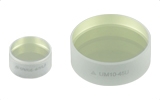 |
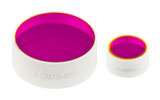 |
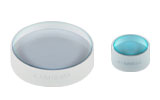 |
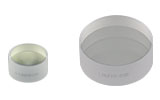 |
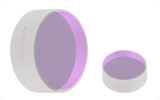 |
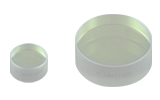 |
| 355 - 445 nm | 460 - 590 nm | 700 - 930 nm | 970 - 1150 nm | 1400 - 1700 nm | 1760 - 2250 nm |
| Dielectric Mirror | High-Power Mirrors for Picosecond Lasers |
Metallic Mirrors | Low-GDD Pump-Through Mirrors |
||
|---|---|---|---|---|---|
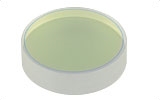 |
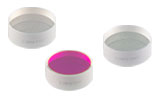 |
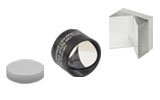 |
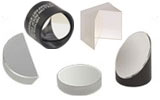 |
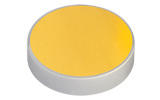 |
 |
| Dual-Band Dielectric Mirror, 400 nm and 800 nm |
Ytterbium Laser Line Mirrors, 250 nm - 1080 nm |
Ultrafast-Enhanced Silver Mirrors, 750 - 1000 nm |
Protected Silver Mirrors, 450 nm - 20 µm |
Unprotected Gold Mirrors, 800 nm - 20 µm |
Pump-Through Mirrors, 1030 - 1080 nm and 940 - 980 nm |
| Deterministic GDD Beamsplitters |
Low-GDD Harmonic Beamsplitters |
Low-GDD Polarizing Beamsplitters |
β-BBO Crystals | Dispersion-Compensating Optics | |
|---|---|---|---|---|---|
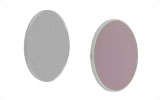 |
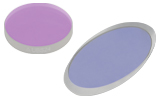 |
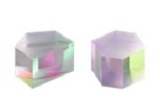 |
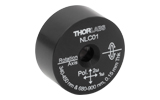 |
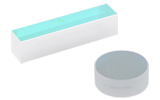 |
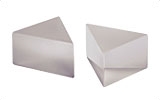 |
| Beamsplitters & Windows, 600 - 1500 nm or 1000 - 2000 nm |
Harmonic Beamsplitters, 400 nm and 800 nm or 500 nm and 1000 nm |
High-Power, Broadband, High Extinction Ratio Polarizers, 700 - 1300 nm |
β-BBO Crystals for Second Harmonic Generation |
Dispersion-Compensating Mirrors, 650 - 1050 nm |
Dispersion-Compensating Prisms, 700 - 900 nm |
Selection Guide for Prisms
Thorlabs offers a wide variety of prisms, which can be used to reflect, invert, rotate, disperse, steer, and collimate light. For prisms and substrates not listed below, please contact Tech Support.
Beam Steering Prisms
| Prism | Material | Deviation | Invert | Reverse or Rotate | Illustration | Applications |
|---|---|---|---|---|---|---|
| Right Angle Prisms | N-BK7, UV Fused Silica, Calcium Fluoride, or Zinc Selenide | 90° | 90° | No | 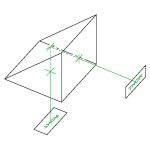 |
90° reflector used in optical systems such as telescopes and periscopes. |
| 180° | 180° | No | 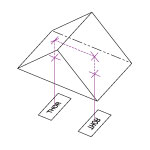 |
180° reflector, independent of entrance beam angle. Acts as a non-reversing mirror and can be used in binocular configurations. |
||
| TIR Retroreflectors (Unmounted and Mounted) and Specular Retroreflectors (Unmounted and Mounted) |
N-BK7 | 180° | 180° | No | 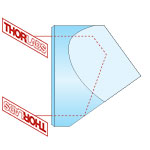 |
180° reflector, independent of entrance beam angle. Beam alignment and beam delivery. Substitute for mirror in applications where orientation is difficult to control. |
| Unmounted Penta Prisms and Mounted Penta Prisms |
N-BK7 | 90° | No | No | 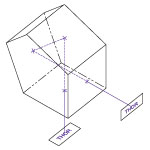 |
90° reflector, without inversion or reversal of the beam profile. Can be used for alignment and optical tooling. |
| Roof Prisms | N-BK7 | 90° | 90° | 180o Rotation | 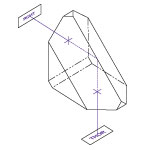 |
90° reflector, inverted and rotated (deflected left to right and top to bottom). Can be used for alignment and optical tooling. |
| Unmounted Dove Prisms and Mounted Dove Prisms |
N-BK7 | No | 180° | 2x Prism Rotation | 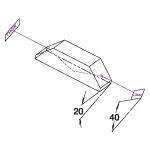 |
Dove prisms may invert, reverse, or rotate an image based on which face the light is incident on. Prism in a beam rotator orientation. |
| 180° | 180° | No | 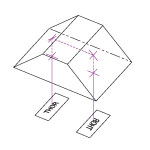 |
Prism acts as a non-reversing mirror. Same properties as a retroreflector or right angle (180° orientation) prism in an optical setup. |
||
| Wedge Prisms | N-BK7 | Models Available from 2° to 10° | No | No |  |
Beam steering applications. By rotating one wedged prism, light can be steered to trace the circle defined by 2 times the specified deviation angle. |
| No | No |  |
Variable beam steering applications. When both wedges are rotated, the beam can be moved anywhere within the circle defined by 4 times the specified deviation angle. |
|||
| Coupling Prisms | Rutile (TiO2) or GGG | Variablea | No | No | 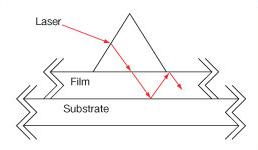 |
High index of refraction substrate used to couple light into films. Rutile used for nfilm > 1.8 GGG used for nfilm < 1.8 |
Dispersive Prisms
| Prism | Material | Deviation | Invert | Reverse or Rotate | Illustration | Applications |
|---|---|---|---|---|---|---|
| Equilateral Prisms | F2, N-F2, N-SF11, Calcium Fluoride, or Zinc Selenide |
Variablea | No | No | 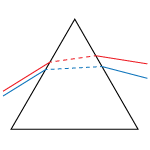 |
Dispersion prisms are a substitute for diffraction gratings. Use to separate white light into visible spectrum. |
| Dispersion Compensating Prism Pairs | Fused Silica, Calcium Fluoride, SF10, or N-SF14 | Variable Vertical Offset | No | No |  |
Compensate for pulse broadening effects in ultrafast laser systems. Can be used as an optical filter, for wavelength tuning, or dispersion compensation.
|
| Pellin Broca Prisms | N-BK7, UV Fused Silica, or Calcium Fluoride |
90° | 90° | No | 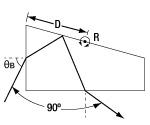 |
Ideal for wavelength separation of a beam of light, output at 90°. Used to separate harmonics of a laser or compensate for group velocity dispersion. |
Beam Manipulating Prisms
| Prism | Material | Deviation | Invert | Reverse or Rotate | Illustration | Applications |
|---|---|---|---|---|---|---|
| Anamorphic Prism Pairs | N-KZFS8 or N-SF11 |
Variable Vertical Offset | No | No | 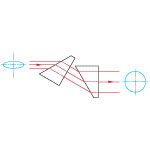 |
Variable magnification along one axis. Collimating elliptical beams (e.g., laser diodes) Converts an elliptical beam into a circular beam by magnifying or contracting the input beam in one axis. |
| Axicons (UVFS, ZnSe) | UV Fused Silica or Zinc Selenide |
Variablea | No | No |
Creates a conical, non-diverging beam with a Bessel intensity profile from a collimated source. |
Polarization Altering Prisms
| Prism | Material | Deviation | Invert | Reverse or Rotate | Illustration | Applications |
|---|---|---|---|---|---|---|
| Glan-Taylor, Glan-Laser, and α-BBO Glan-Laser Polarizers | Glan-Taylor: Calcite Glan-Laser: α-BBO or Calcite |
p-pol. - 0° s-pol. - 112°a |
No | No | 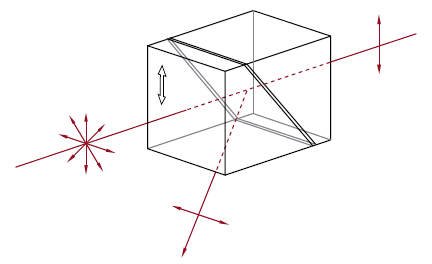 |
Double prism configuration and birefringent calcite produce extremely pure linearly polarized light. Total Internal Reflection of s-pol. at the gap between the prism while p-pol. is transmitted. |
| Rutile Polarizers | Rutile (TiO2) | s-pol. - 0° p-pol. absorbed by housing |
No | No | 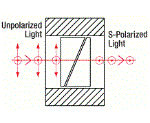 |
Double prism configuration and birefringent rutile (TiO2) produce extremely pure linearly polarized light. Total Internal Reflection of p-pol. at the gap between the prisms while s-pol. is transmitted.
|
| Double Glan-Taylor Polarizers | Calcite | p-pol. - 0° s-pol. absorbed by housing |
No | No | 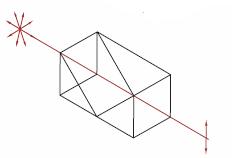 |
Triple prism configuration and birefringent calcite produce maximum polarized field over a large half angle. Total Internal Reflection of s-pol. at the gap between the prism while p-pol. is transmitted. |
| Glan Thompson Polarizers | Calcite | p-pol. - 0° s-pol. absorbed by housing |
No | No |  |
Double prism configuration and birefringent calcite produce a polarizer with the widest field of view while maintaining a high extinction ratio. Total Internal Reflection of s-pol. at the gap between the prism while p-pol. is transmitted. |
| Wollaston Prisms and Wollaston Polarizers |
Quartz, Magnesium Fluoride, α-BBO, Calcite, Yttrium Orthovanadate | Symmetric p-pol. and s-pol. deviation angle |
No | No | 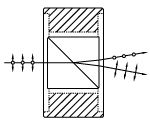 |
Double prism configuration and birefringent calcite produce the widest deviation angle of beam displacing polarizers. s-pol. and p-pol. deviate symmetrically from the prism. Wollaston prisms are used in spectrometers and polarization analyzers. |
| Rochon Prisms | Magnesium Fluoride or Yttrium Orthovanadate |
Ordinary Ray: 0° Extraordinary Ray: deviation angle |
No | No |  |
Double prism configuration and birefringent MgF2 or YVO4 produce a small deviation angle with a high extinction ratio. Extraordinary ray deviates from the input beam's optical axis, while ordinary ray does not deviate. |
| Beam Displacing Prisms | Calcite | 2.7 or 4.0 mm Beam Displacement | No | No | 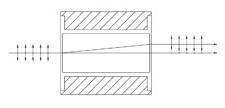 |
Single prism configuration and birefringent calcite separate an input beam into two orthogonally polarized output beams. s-pol. and p-pol. are displaced by 2.7 or 4.0 mm. Beam displacing prisms can be used as polarizing beamsplitters where 90o separation is not possible. |
| Fresnel Rhomb Retarders | N-BK7 | Linear to circular polarization Vertical Offset |
No | No | 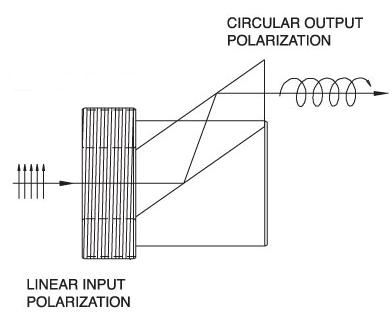 |
λ/4 Fresnel Rhomb Retarder turns a linear input into circularly polarized output. Uniform λ/4 retardance over a wider wavelength range compared to birefringent wave plates. |
| Rotates linearly polarized light 90° | No | No |  |
λ/2 Fresnel Rhomb Retarder rotates linearly polarized light 90°. Uniform λ/2 retardance over a wider wavelength range compared to birefringent wave plates. |
Beamsplitter Prisms
| Prism | Material | Deviation | Invert | Reverse or Rotate | Illustration | Applications |
|---|---|---|---|---|---|---|
| Beamsplitter Cubes | N-BK7 | 50:50 splitting ratio, 0° and 90° s- and p- pol. within 10% of each other |
No | No | 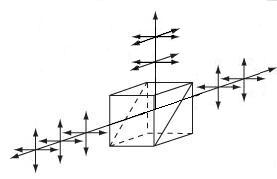 |
Double prism configuration and dielectric coating provide 50:50 beamsplitting nearly independent of polarization. Non-polarizing beamsplitter over the specified wavelength range. |
| Polarizing Beamsplitter Cubes | N-BK7, UV Fused Silica, or N-SF1 | p-pol. - 0° s-pol. - 90° |
No | No | 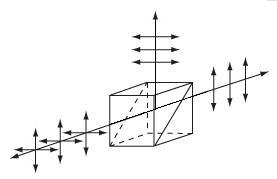 |
Double prism configuration and dielectric coating transmit p-pol. light and reflect s-pol. light. For highest polarization use the transmitted beam. |
| Posted Comments: | |
Zhengru Guo
(posted 2024-07-31 13:46:16.787) The dispersion curves gived by you and Newport are so different. According to Newport, "SF10 glass prisms provide group velocity dispersion of 1600 fsec2/cm at 800 nm". However, with your curve, SF10 glass prisms provide group velocity dispersion of ~100 fsec2/cm at 800 nm. It's so different, which can I trust? jpolaris
(posted 2024-08-01 04:57:23.0) Thank you for contacting Thorlabs. The GVD and TOD data for our AFS-series prisms, including AFS-SF10, represents values for prism pairs separated by a distance of 10 mm and with an angle of incidence equivalent to the Brewster's angle of the material. These data do not represent just the substrate itself in isolation. This is discussed on our Tutorial page found at the following link. https://www.thorlabs.com/newgrouppage9.cfm?objectgroup_id=3242&tabname=Tutorial hyo s
(posted 2024-07-16 09:58:42.99) Hi! May I ask for the transmittance data within the range of 800-1000 nm, if possible? Thank you. jpolaris
(posted 2024-07-16 07:36:37.0) Thank you for contacting Thorlabs. The transmission through these dispersion-compensating prisms pairs will depend on the material substrate. We offer these prisms in four different substrates -- CaF2, fused silica, SF10, and N-SF14. I have reached out to you directly with transmission data for each of these substrates. Zhongcheng Wang
(posted 2023-12-30 00:22:50.093) Hello, may I ask, the main difference between these four prism pairs is the difference in dispersion compensation? Why are prism pairs with flat dispersion curves and smaller absolute values more expensive? Is it because something else has an advantage in terms of pulse width compression? jpolaris
(posted 2024-01-02 06:34:14.0) Thank you for contacting Thorlabs. The difference in price between the dispersion-compensating prisms that we offer is primarily attributable to the procurement costs for the various substrates. For instance, CaF2 is more expensive as a raw material than UV fused silica, SF10, and N-SF14. In terms of specifications, the CaF2 prism has a better surface quality than the prisms made from the other substrates. When making a decision on which prism to use, you would need to determine how much compensation is needed, as well as to consider the amount of space available in your setup. The accumulated phase, and therefore also GD, GVD, and TOD, is dependent on the prism spacing and substrate material. We discuss this in greater detail at the following link:
https://www.thorlabs.com/newgrouppage9.cfm?objectgroup_id=3242&tabname=Tutorial Patrick H
(posted 2023-07-11 14:31:02.993) Is the SF-14 also usable for dispersion compensation at 1064nm? cdolbashian
(posted 2023-07-21 02:02:14.0) Thank you for reaching out to us Patrick. While we do not spec performance of these components with this particular wavelength, compensation can be achieved, and tuned, by changing the inter-prism spacing, as well as the incident angles on each prism. Fundamentals of the design and operation of such a prism pair can be seen in the paper which we reference in our "tutorial" tab of that product page:
[1] R. L. Fork, O. E. Martinez, and J. P. Gordon, "Negative dispersion using pairs of prisms," Opt. Lett. 9, 150-152 (1984) Fu min
(posted 2022-06-22 10:44:47.873) I want to konw the Dispersion formula of SF10,and its reflractive index. cdolbashian
(posted 2022-06-24 03:30:42.0) Thank you for reaching out to us with this inquiry. I have contacted you directly with the appropriate information. Paul Bittorf
(posted 2021-11-29 10:14:55.527) Dear Sir or Madam, for a new ultrafast laser setup we plan to include multiple prism pairs for the fundamental (~800 nm), second and third harmonic for dispersion compensation. On your site, you present the prism pairs designed for the wavelength range of 700 - 900 nm, which is only perfect for the fundamental. Can we use the same prisms as well for the second (~400 nm) and third (~266 nm) harmonic or is there a big difference in the refractive index for such wavelengths and therefore a huge tradeoff? Also, does the material have an important impact besides the lenght of the compensator? Thank you for answering. Best regards, Paul Bittorf cdolbashian
(posted 2021-12-22 04:51:04.0) Thank you for reaching out to us Paul. These prisms can indeed be used for other wavelengths, though you would need to adjust the angle of the prisms and the inter-prism spacing. The governing equations and referenced research paper can be found on the "Tutorial" tab on this page. The material, N-BK7, has a known index of refraction which helps to determine the spacing and angle. Please feel free to reach out to us in the future with any other inquiries. John Linden
(posted 2021-06-29 14:55:53.713) Dear Rep.
I am looking for a solution to correct beam ellipticity for UV 343nm with pulsewidth of ~250fs. is this product sufficient?
I think the anamorphic prism pair is a good product but not sure of the compatability with ultrafast UV laser. Also it seems UV is not the designed wavelength for the AFS-FS as well. Appreciate any recomendation. cdolbashian
(posted 2021-07-20 01:09:05.0) Thank you for contacting us at Thorlabs. Given a 250fs pulsewidth for a laser in the UV range, a sufficient method for correcting beam ellipticity would be a pair of UV-fused silica, plano-convex lenses, rather than this prism pair. The function of this prism pair is used to correct for pulse broadening, which occurs when ultrafast pulses pass through a dispersive material. For your pulse duration, and the thickness of a standard lens of UV fused silica, the pulse broadening should be negligible. I have reached out to you directly to discuss different options. lokirune
(posted 2018-08-26 23:48:22.507) Hi. I bought this, but the size is smaller than I expected ( even I looked at the spec before I bought), so I couldn't put this in my system. Do you have other options with bigger size and coating for a lower wavelength(300nm)? If not, is it OK to buy just 2 right angle prisms? Thanks. YLohia
(posted 2018-08-27 05:59:43.0) Hello, thank you for contacting Thorlabs. We do have the ability to offer custom prism pairs, depending on your specific requirements and order quantity. Custom item orders should be placed through techsupport@thorlabs.com. We will reach out to you directly to discuss your requirements. Though an equilateral prism would likely work better, a right angle prism would work as well as long as you are prepared to solve the equations shown on the Tutorial tab of this page. lokirune
(posted 2018-05-22 22:54:09.68) about the AFS-CAF, is it OK to use with high power pulsed laser ? ( for example, 5ns 20W 532nm)
Thanks. YLohia
(posted 2018-05-23 08:59:13.0) Hello, thank you for contacting Thorlabs. Unfortunately, we do not currently have test data for our uncoated CaF2 substrates since we do not manufacture the raw material itself. The actual damage threshold is also dependent on factors such as beam diameter and repetition rate of the laser (is 20 W the peak power or the average power?). That being said, CaF2 is general considered to be a "high damage threshold" material and is used in high power pulsed applications so it is likely for this to work for you, though we cannot provide any guarantees due to the lack of data. user
(posted 2017-05-30 16:01:15.873) Will these prisms work at longer wavelengths - e.g. in the range 2-3 micrometers? Do you offer any AR coated options please? tfrisch
(posted 2017-06-22 09:09:11.0) Hello, thank you for contacting Thorlabs. We can offer these with other coatings, but at longer wavelengths, the distance between the prisms will need to be increased to compensate for the lower dispersion of the substrate. Please contact TechSupport@Thorlabs.com to discuss the requirements of your custom application. ethewalt
(posted 2015-11-05 13:20:59.727) The GVD graph on the dispersion-compensating prism pair page needs to be fixed. The labels for fused silica and calcium fluoride are interchanged, and the horizontal gridlines don't correspond to the GVD axis labels. besembeson
(posted 2015-11-05 01:48:40.0) Response from Bweh at Thorlabs USA: Thanks for bringing this to our attention. We are going to fix the graphs on the website. user
(posted 2015-08-25 22:07:19.71) There is a typo in the formula for theta_f in the tutorial. There is an "arcsin" and an "asin". Choose one :) myanakas
(posted 2015-08-28 03:48:27.0) Response from Mike at Thorlabs. Thank you for your feedback. This typo has been corrected and we apologize for any inconvenience this may have caused. tianzhushang
(posted 2013-08-22 14:50:37.537) I've bought the AFS-SF14,How could I set the length between the two prisms and Can you e-mail me the data with the method to calculate it? jlow
(posted 2013-09-17 17:06:00.0) Response from Jeremy at Thorlabs: We have a sample calculations PDF linked in the "Specs" tab on our website. Our web team is looking to re-post a revised, updated version which should be clearer. We will contact your directly to discuss about this in more detail. 357510589
(posted 2012-10-16 09:50:54.14) 您好,刚看了贵公司的色散补偿棱镜,在这里有两张图,分别为二阶、三阶色散因子图,请问这个图是指单纯的材料色散吗?(即仅与材料组成有关,与棱镜外形及空间位置无关),另外,在使用此棱镜对,进行色散补偿时,根据你们的教程,没看太明白,能否提供更详细的教程不?期待着您好回复,谢谢! bdada
(posted 2011-10-07 18:19:00.0) Response from Buki at Thorlabs:
Thank you for your feedback. We will be happy to provide you with this data or the appropriate method to calculate it. We need the part number of the prism pair you are using and the configuration of the prisms.
We also have MathCad files for some of our dispersion prisms that we have emailed to you. Please contact TechSupport@thorlabs.com if you have further questions. avle
(posted 2011-09-26 23:55:36.0) Hi there,
I was wondering how we would calculate the negative dispersion parameter for a given prism set, with known optical properties and geometric configuration of the prism pair?
The dispersion parameter in units of ps/nm
Thanks! jjurado
(posted 2011-06-24 18:27:00.0) Response from Javier at Thorlabs to lionel.tombez: Thank you very much for contacting us. The AFS-SF10 dispersion compensation prism pairs will certainly transmit well at 1.1um. The prisms are cut at the same angle as Newport's prisms, so the performance will be identical. lionel.tombez
(posted 2011-06-23 09:08:08.0) Can one use these prisms (SF10) to compress 1.1 um pulses ? I dont get the difference with Newport prism compressor product, which is of the same material (SF10) but specified up to 2.3um.
Thanks Customer Email: lionel.tombez@unine.ch This customer would like to be contacted. Greg
(posted 2011-01-11 10:23:19.0) A response from Greg at Thorlabs to william.t.lotshaw: Thank you for pointing out this error. The graphs were incorrect and have been fixed. william.t.lotshaw
(posted 2011-01-10 11:22:58.0) The GVD and TOD curves for fused silica and CaF2 appear to be reversed in the graphs tab if the values you list in the overview for the Brewster dispersion compensation prisms is correct Javier
(posted 2010-06-17 10:39:21.0) Response from Javier at Thorlabs to jessew: our specifications list the total TOD for the prism compressor. We derived the GVD and TOD values based on accumulated phase of the prism compressor. I can send you a document which outlines the derivation for these values. jessew
(posted 2010-06-16 23:08:50.0) Im unclear on how the numbers for TOD were derived for the prism pairs. Is the material TOD listed, or total TOD for a compressor constructed out of the prism pair?
For example, using the standard definition of material TOD as the third derivative of wave number k with respect to angular frequency omega, TOD for SF10 should be 0.10 fs^3/rad per micrometer of material propagation.
Thanks,
-Jesse Wilson |
 Products Home
Products Home













 Dispersion Compensation Prism Pairs
Dispersion Compensation Prism Pairs